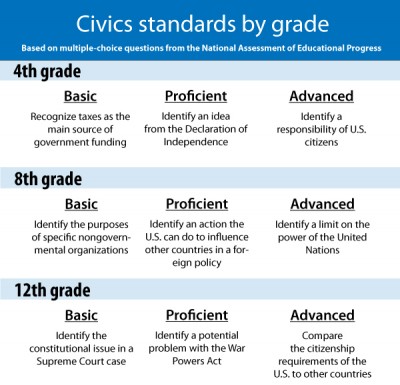When it comes to how much our country’s students know about civics, the results are decidedly mixed. Scores from the National Assessment of Educational Progress 2010 civics test, released today, reveal that fourth-graders turned in a record performance. But there was no statistically significantly change for eighth-graders, and 12th-graders actually did worse this time than they did when the test was given in 1998 and 2006.
NAEP — commonly known as the Nation’s Report Card — tests students on “civic knowledge, intellectual and participatory skills, and civic dispositions” in this particular exam, with both multiple-choice and open-ended questions.
Twenty-nine percent of fourth-graders were proficient or advanced in 2010, along with 23 percent of eighth-graders and 28 percent of 12th-graders.
You can check out the full report for more details. Here’s a sampling of some of the interesting findings by grade-level:
- The gaps between black and white students and between Hispanic and white students have narrowed significantly among fourth-graders, although a gap certainly remains. On the other hand, the disparity between male and female students has widened, with girls outscoring boys by seven points, up from two points in each of the previous rounds of the test.
- The most-taught topic in eighth grade was the U.S. Constitution, with 82 percent of students saying they studied it during the school year. Runners up were Congress, with 78 percent of students saying they learned about it that year, and “political parties, elections, and voting” at 75 percent. By contrast, only 40 percent of eighth-graders reported studying other countries’ governments, and only 33 percent said they learned about international organizations.
- Also in eighth grade, scores went up across income levels, but they increased the most for students who qualify for reduced-price lunch. These students saw their scores jump five points, as opposed to a three-point increase for both those eligible for free lunch and those not eligible for either.
- While twelfth-grade scores declined overall, two groups saw a slight increase from 2006: Hispanics and American Indians/Alaska Natives.
- Though the gender gap widened in fourth grade, it disappeared in twelfth grade — but not because boys were catching up. Both males and females scored worse than in 2006, with males dropping by two points and females by four.




